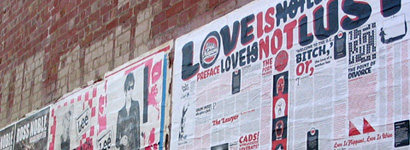In this late edition of Quipsologies: Many things.


The streets of Australia are a bit smarter thanks to Is Not Magazine. “it has been on display at 50 outdoor poster sites in inner-city Melbourne as well as cafes, shops, and laundromats,” writes Jeremy Wortsman, one of the founders, the purpose, he adds, is to “engage people in outdoor, communal reading, and enriching public space”. And how can you not enrich public space with Underware’s Bello?
Apple releases Tiger. Journalists release clichés.

Two Adobe items:
Adobe Stock Photo. Search and purchase from more than 230,000 Royalty-Free images from top stock photography libraries directly within Adobe CS2 applications.
And…
Adobe Creative Suite 2 now shipping.
It took child’s play for Takashi Hashiyama, president of Maspro Denkoh Corporation, to decide who would auction his art collection. Rock, paper…
Banned from Apple. By Apple

Vancouver 2010 Winter Olympics Logo Unveiled.
Cranbrook Design Relaunches.

Their links are good too.
Pope Benedict XVI has unique ideas about images and contemporary Iconoclasm — I call it Modernism.
Yet another reason to avoid using stock photography.






CS2—So we have Photoshop 6, 7, etc. Then we get CS and everyone asks why? Why not keep with the numbering system that all software has used since we first had software? And how are they going to name next year's version? Now we know: it's Photoshop CS2! Fucking brilliant! So we're still asking why?
I could go on at length about how absolutely terrible Vancouver's Olympics logo is, but I wont. It's already been commented on at length. It sucks...ass. No need to say more. hhmmm...ok can't help it—When you have a province that was home to what some might argue was the most incredible societies in the world's history, one rich with its own art that so happens to be "graphic" by nature, why on earth would you go and choose an Inukshuk! Not to mention a terribly rendered Inukshuk. I can't even look at that bloody thing without having a seizure.
Cranbrook design needs to re-relaunch.
A friend recently showed me a magazine in which the same stock photo was used for two completely unrelated ads on opposite pages...don't use stock photography.
On May.04.2005 at 06:59 PM